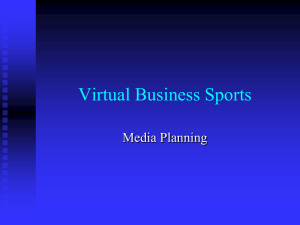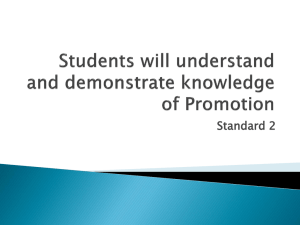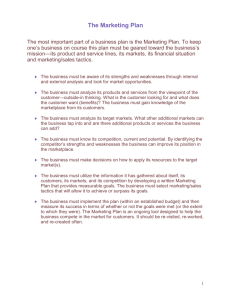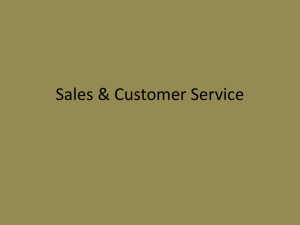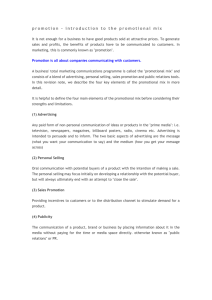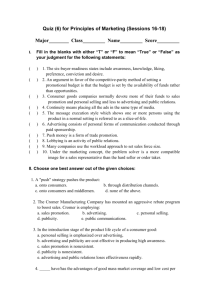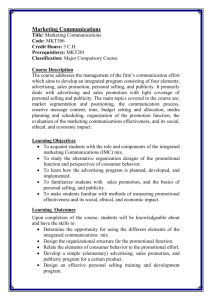Entrepreneurship_CH6
advertisement
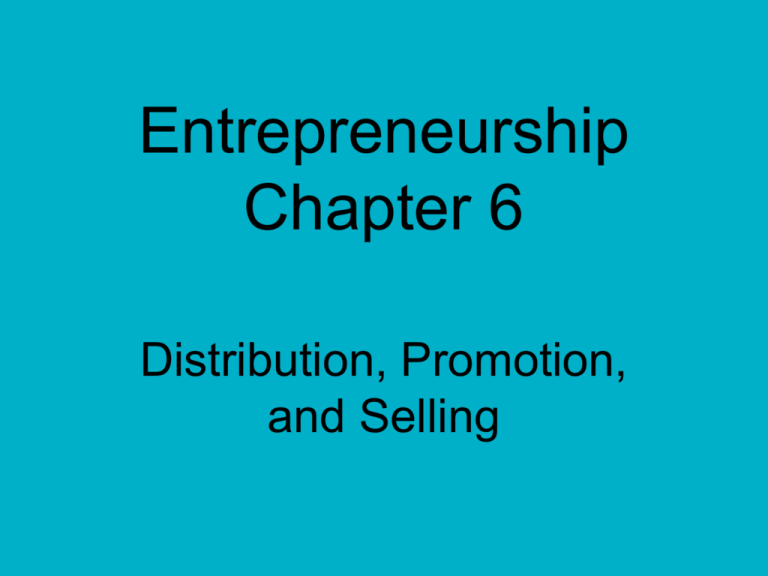
Entrepreneurship Chapter 6 Distribution, Promotion, and Selling Marketing Mix Marketing Mix – Helps meet customer needs and enables the business to earn a profit. – reaching target market through a blend of: • Product • Price Chapter 5 • Distribution • Promotion Chapter 6 2 The Marketing Mix – Distribution Section 6-1 • Goals: – Describe the four basic options of channels of distribution. – Apply channels of distribution to the specific needs of various types of businesses. – List factors to consider in the physical distribution of products. 3 Focus on Small Business • What do you think happened to Dustin’s order? • What is the problem? • How do you think Dustin should handle this situation? 4 Channels of Distribution 6.1 • Distribution: an important component of the marketing mix that involves the locations and methods used to make products available to customers • Channels of Distribution: routes that products and services take from the time they are produced to the time they are consumed 5 Channels of Distribution 6.1 • Direct Channel: moves the product directly from the manufacturer to consumer • Indirect Channel: distribution channel that uses intermediaries to move products between the manufacturer and the consumer – Intermediaries: agents and wholesalers 6 Channel Options • • • • 6.1 Manufacturer to Consumer Man. Retailer Con. Man. Wholesaler Ret. Con. Man. Agent Whol. Ret. Con. Page 149 - Channels of Distribution Chart 7 Distribute Goods and Services • Retail Business – Offer your product or service to consumers in a convenient location during convenient hours – Use catalogs, fliers, and other advertisements to reach customers who live outside the area. – Take phone/fax orders and ship them directly to the customers. – Create a website. Customers can learn about your products and make purchases online. 8 Distribute Goods and Services • Service Business – Most sell their services directly to consumers – Single Direct Channel of Distribution – Production and consumption of a service happens all at once. – Needs to occur WHEN the consumer wants it. – Electricians, Restaurant Owners, Lawyers – Deal directly with consumer wanting the service 9 Distribute Goods and Services • Manufacturing Businesses – Don’t usually sell directly to consumers – Make their products & sell to other businesses – Some will distribute their products very broadly and use many channels – Some will distribute through select outlets only – Cosmetics • High End Exclusive Department Stores • Inexpensive Discount Stores & Drugstores 10 Physical Distribution • Physical Distribution includes: – Transportation – Product Storage and Handling – Packaging of products within a channel of distribution. (Next 3 slides…) 11 Physical Distribution • Transportation – Consider what and where you are shipping – Perishables need refrigeration & speed – Airplane, Railroad, Ship, Truck, Combination 12 Physical Distribution • Product Storage and Handling – Efficient storage allows the channels to balance supply and demand of the products. – Adds to cost of product, risk of damage or theft – Stored in warehouses at various channels 13 Physical Distribution • Packaging – Designed to protect the product from the time it is produced until it is consumed. – Protected from being damaged/destroyed which would result in loss of money – Depends on product, shipping & destination • Receiving Goods to Sell – All types of businesses must receive goods from suppliers even if they don’t sell them to consumers (office supplies, raw materials) 14 Where can you find information? • Directories that list suppliers and manufacturers for a wide range of industries • Magazines for specific industries • The Internet • Publications include: – The American Wholesalers and Distributors Directory – The Thomas Register 15 6.1 Benefits Gained 6.1 • Improves economic efficiency • Results in a better assortment of products for consumers • Helps make transactions routine • Makes it easier for consumers to find goods and services. • Example: Georgia Peach Farmer uses an intermediary to sell produce to Midwest customers (where few peaches are grown). Consumers know grocery store has peaches; No searching for local 16 growers. Grocery store = routine transaction. Checkpoint Questions • What are the 4 basic options of channels of distribution? #1 MC #3 MWRC #2 MRC #4 MAWRC • Why are channels of distribution different for different types of businesses? Distribution needs are based on size of market, type of product/service, and customer needs & wants. • What factors are important to consider in the physical distribution of products? #1 Transportation #2 Product Storage Handling #3 Packaging Needs 17 The Marketing Mix - Promotion Section 6-2 • Goals: – List the many forms of advertising and discuss the advantages and disadvantages of each. – Define publicity and describe ways to use publicity as a promotional tool. 6.2 Nearly every slide has a workbook answer on it this time. 18 Focus on Small Business • Do you think Chachi’s idea for an opening day promotion ids a good one? Why or Why Not? • Can you suggest some alternative promotions that Chachi might use? 19 Promotional Strategies • You will have to promote your business to make customers aware of the benefits of buying from you. • Promotion can take many forms: – Advertising, Publicity, Personal Selling, Sales Promotion • Promotional Mix – strategy created by adopting a blend of some, if not all the forms 20 Promotional Strategies • Advertising: a paid form of communication sent out by a business about a product. • Keeps your product in the public’s eye by creating a sense of awareness. • Choose your message carefully 21 Online Advertising • Types of Online Advertising: – Banner Ad: graphic image or animation displayed within a rectangular box across top or down the side of a web page. – Floating Ad: An ad which moves across the screen or floats above the page content. – Wallpaper Ad: an ad which changes the background of the page being viewed. – Trick Banner: a banner ad that looks like a dialog box with buttons, often appearing like an error message or alert. – Pop-Up Ad: a new window that opens in front of the current 22 one, displaying an advertisement. Online Advertising • Paying for Online Advertising: – Cost per Mil (CPM): exposure of the message – Cost per Click (CPC): number of user clicks on Ad – Cost per Action (CPA): user completing form, registering for newsletter or some other action. • Disadvantages: • Abuse – spamming: sending mass bulk emails • Excessive use of pop-ups, flashy banners and spam has cause internet users to block these advertisements. 23 Television Advertising • TV Promotions reach millions every day. • Best way to reach large numbers quickly. • Commercials and Paid Ads (Infomercials) • Disadvantages: – Very expensive – Reach too broad of an audience 24 Radio Advertising • Less expensive that television promotion • More certain you are reaching target market • Radio Stations tend to narrow down the target market for you • Disadvantages: – Purely audio, no visuals of your product – Listeners may not remember what they hear – Listeners may change station at commercials 25 Newspaper • Single largest form of advertising in U.S. • Relatively inexpensive • Targets a limited geographic area • Reaches large number of people • Disadvantages: – More people looking to Internet, less newspaper – May be paying to reach thousands outside of your target – A lot of competition advertised right next to you. 26 Telephone Directory Advertising • List of phone numbers of people & businesses • Directory ads will appear on a page near the listing and phone number. • Similar to Newspaper Ads • Used repeatedly • Disadvantages: – Lack of persuasion in a listing – Listed next to competition – May already know what business they were looking for 27 Direct-Mail Advertising • Direct-Mail advertising includes: – Fliers, catalogs, letters & other correspondence sent to target customers through mail. • Purchase mailing list which fit your target – Companies specialize in maintaining targeted mailing lists and sell them to businesses • Disadvantages: – Only Effective IF people read it! – Sometime considered – “Junk Mail” 28 Magazine Advertising • Magazines are an excellent way to aim products at specific markets • Fitness magazine – equipment & apparel • Teen magazine – cosmetics, clothing, shoes • Disadvantages: – Most magazine are nationally distributed; Not good for limited geographic selling 29 Outdoor Advertising • Includes: – Billboards and Signs • Effective in keeping your name out there where many people can see it. • Disadvantages: – Does not offer very much information – Drive-by readings must be - short and sweet Transit Advertising • Consists of signs on public transportation. • Provides much more info than Outdoor Ads. • Inside and outside of vehicles • Inside Transit Ads offers the riders something to read for the duration of the trip. • Disadvantages: – Effective only if target market commonly uses public transportation Promotional Strategies Publicity • Publicity: non-paid form of communication that calls attention to your business through media coverage. • Good publicity can be helpful advertising • Publicity is free & largely out of your control • Can be negative if coverage is unfavorable 32 Publicity • Press Release: a written statement meant to inform the media of an event or product. – Example Page 162 • Elements of a Press Release • Date and Time • Food and Beverage Provided? • Celebrity Entertainment? • Company Information • Product Information 33 Publicity • Public Relations: establishing a favorable relationship with customers & general public. – Public awareness and positive public relations can generate business when you show community involvement and commitment. • • • • • Sponsor a community sports team Make donations to local charity/relief efforts Work-based programs through local high school Active members of local Big Brother/Sister Program Organize community program - clean up parks 34 Publicity • Self-Promotion helps keep the company name visible and in the forefront of the people’s mind. – Giving away t-shirts and hats displaying your company name and logo. – Distributing pens, notepads, coffee mugs, and other useful items printed with company info. 35 Checkpoint Questions • Why is promotion important to a business? A business will not succeed if target customers are not aware of it and what it has to offer. • What are advantages/disadvantages of publicity? Good publicity can be helpful as no-cost (free) advertising. But largely out of the business’s control and if it is negative, it could turn customers away. 36 Selling & Promoting Section 6-3 • Goals: – Explain the role of selling in a business – Determine how to meet customer needs & wants – Discuss other types of promotional activities 37 Focus on Small Business • Do you think that JoJo is making a good decision in adding a retail clothing line to her dance studio? Why or Why Not? • What kinds of promotions do you think JoJo should use to try and attract new customers? 38 Promotional Strategies Selling 6.3 • Personal Selling: direct communication between a prospective buyer & a sales rep. – Sales representative attempts to influence the prospective buyer in a purchase situation. • Thorough Product Knowledge - Salesperson – Features: physical characteristics/capabilities – Benefits: advantages of products 39 Selling Determine Customer Needs & Wants • Needs Assessment – Salesperson finds out as much info about customers situation. – Identifies the range of options for the customer – Need Satisfying - fulfill consumer needs – Problem Resolution - assess problem, gather info, act as consultant to assist customer 40 Selling Determine Customer Needs & Wants • Buying Decisions – Rational B.D. based on logical reasoning of customers Safety, simplicity, quality, reliability, economy, convenience, service, durability, knowledge, $ gain, ease of operation – Emotional B.D. based on desire to have specific product Feelings, beliefs and attitude: fear, protection, appearance, recreation, improved health, comfort, recognition, pride, prestige and popularity 41 Selling Determine Customer Needs & Wants • Customer Decision-Making • • • • • • • Define the problem Gather information Identify various solutions Evaluate alternatives Select the options Take action Evaluate the actions – Salesperson can help in this decision process 42 Promotional Strategies Sales Promotion • Sales Promotion: an incentive offered to customers in order to increase sales. – Contests, Free Samples, Rebates, Coupons, Special Events, Gift Certificates, Frequent Buyers – Rebate: a refund offered to people who purchase a product. • Telemarketing: using the phone to market your product or service 43 Checkpoint Questions • Why is selling important to a business? – Makes money for the business • Why is it important to meet customer needs and wants in the selling process? – Customers purchase goods and services in order to satisfy needs and wants. If these cannot be met by the business, no sales will be made. 44
